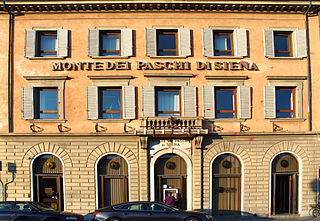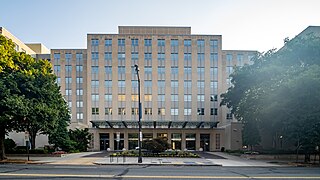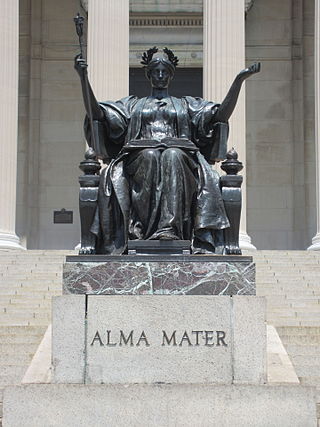
A college may be a tertiary educational institution, part of a collegiate university, an institution offering vocational education, a further education institution, or a secondary school.

The European Union (EU) is a supranational political and economic union of 27 member states that are located primarily in Europe. The Union has a total area of 4,233,255 km2 (1,634,469 sq mi) and an estimated total population of over 449 million. The EU has often been described as a sui generis political entity combining the characteristics of both a federation and a confederation.

Michael Faraday was an English physicist and chemist who contributed to the study of electromagnetism and electrochemistry. His main discoveries include the principles underlying electromagnetic induction, diamagnetism and electrolysis. Although Faraday received little formal education, as a self-made man, he was one of the most influential scientists in history. It was by his research on the magnetic field around a conductor carrying a direct current that Faraday established the concept of the electromagnetic field in physics. Faraday also established that magnetism could affect rays of light and that there was an underlying relationship between the two phenomena. He similarly discovered the principles of electromagnetic induction, diamagnetism, and the laws of electrolysis. His inventions of electromagnetic rotary devices formed the foundation of electric motor technology, and it was largely due to his efforts that electricity became practical for use in technology.

The National Academy of Sciences (NAS) is a United States nonprofit, non-governmental organization. NAS is part of the National Academies of Sciences, Engineering, and Medicine, along with the National Academy of Engineering (NAE) and the National Academy of Medicine (NAM).

The Smithsonian Institution, or simply the Smithsonian, is a group of museums, education and research centers, created by the U.S. government "for the increase and diffusion of knowledge." Founded on August 10, 1846, it operates as a trust instrumentality and is not formally a part of any of the three branches of the federal government. The institution is named after its founding donor, British scientist James Smithson. It was originally organized as the United States National Museum, but that name ceased to exist administratively in 1967.

The University of North Carolina is the public university system for the state of North Carolina. Overseeing the state's 16 public universities and the NC School of Science and Mathematics, it is commonly referred to as the UNC System to differentiate it from its first campus, UNC-Chapel Hill.

A financial institution, sometimes called a banking institution, is a business entity that provides service as an intermediary for different types of financial monetary transactions. Broadly speaking, there are three major types of financial institution:
- Depository institution – deposit-taking institution that accepts and manages deposits and makes loans, including bank, building society, credit union, trust company, and mortgage broker;
- Contractual institution – insurance company and pension fund
- Investment institution – investment bank, underwriter, and other different types of financial entities managing investments.

The Hoover Institution is an American public policy think tank which promotes personal and economic liberty, free enterprise, and limited government. While the institution is formally a unit of Stanford University, it maintains an independent board of overseers and relies on its own income and donations. It is widely described as conservative, although its directors have contested the idea that it is partisan.

An institution is a humanly devised structure of rules and norms that shape and constrain social behavior. All definitions of institutions generally entail that there is a level of persistence and continuity. Laws, rules, social conventions and norms are all examples of institutions. Institutions vary in their level of formality and informality.

The Brookings Institution, often stylized as Brookings, is an American think tank that conducts research and education in the social sciences, primarily in economics, metropolitan policy, governance, foreign policy, global economy, and economic development.

Magdalene asylums, also known as Magdalene laundries, were initially Protestant but later mostly Roman Catholic institutions that operated from the 18th to the late 20th centuries, ostensibly to house "fallen women".

Anna University is a public state university located in Chennai, Tamil Nadu, India. The main campus is in Guindy. It was originally established on 4 September 1978 and is named after C.N.Annadurai, the former Chief Minister of Tamil Nadu.

A public university or public college is a university or college that is owned by the state or receives significant funding from a government. Whether a national university is considered public varies from one country to another, largely depending on the specific education landscape. In contrast a private university is usually owned and operated by a private corporation. Both types are often regulated, but to varying degrees, by the government.

Private universities and private colleges are higher education institutions not operated, owned, or institutionally funded by governments. However, they often receive tax breaks, public student loans, and government grants. Depending on the country, private universities may be subject to government regulations. Private universities may be contrasted with public universities and national universities which are either operated, owned and or institutionally funded by governments. Additionally, many private universities operate as nonprofit organizations.
Redshirt, in United States college athletics, is a delay or suspension of an athlete's participation in order to lengthen their period of eligibility. Typically, a student's athletic eligibility in a given sport is four seasons, aligning with the four years of academic classes typically required to earn a bachelor's degree at an American college or university. However, in a redshirt year, student athletes may attend classes at the college or university, practice with an athletic team, and "suit up" for play – but they may compete in only a limited number of games. Using this mechanism, a student athlete (traditionally) has at most five academic years to use the four years of eligibility, thus becoming what is termed a fifth-year senior. Due to the COVID-19 pandemic, an additional year of eligibility was granted by the NCAA to student athletes who met certain criteria. Student athletes who qualified had up to six academic years to make use of their four years of eligibility, taking into consideration the extra year provided due to exceptional circumstances.

SRM Institute of Science and Technology (SRMIST), formerly SRM University, is a private deemed university, located in Kattankulathur, Chengalpattu, Tamil Nadu, India. Founded in 1985 as SRM Engineering College in Kattankulathur, it gained the deemed University status in 2002. SRM Institute of Science and Technology is spread across five campuses — Kattankulathur, Ramapuram, Vadapalani,(all in Chennai), Ghaziabad and Tiruchirappalli. Those are all same University as per section 3 of University Grants Commission Act, 1956. It has three sister universities in Andhra Pradesh, Haryana and Sikkim.
The athletic nickname, or equivalently athletic moniker, of a university or college within the United States and Canada is the name officially adopted by that institution for at least the members of its athletic teams. Typically as a matter of engendering school spirit, the institution either officially or unofficially uses this moniker of the institution's athletic teams also as a nickname to refer to people associated with the institution, especially its current students, but also often its alumni, its faculty, and its administration as well. This practice at the university and college tertiary higher-education level has proven so popular that it extended to the high school secondary-education level in the United States and Canada and even to the primary-education level as well.

A university is an institution of tertiary education and research which awards academic degrees in several academic disciplines. University is derived from the Latin phrase universitas magistrorum et scholarium, which roughly means "community of teachers and scholars". Universities typically offer both undergraduate and postgraduate programs.

















